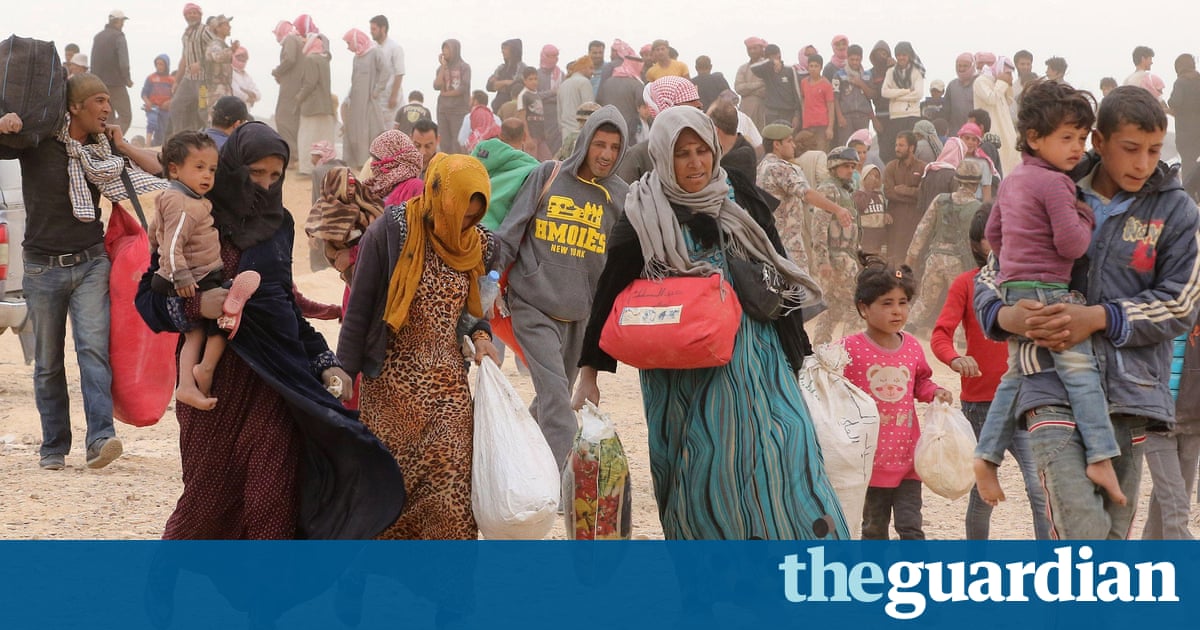Plight of tens of thousands of Syrians could undermine Jordans role as co-host of major summit on refugees, activists warn

Tens of thousands of ghost refugees who have been trapped in the desert along Jordans border with Syria for more than two months face food and water shortages and are at risk of epidemics, aid workers say.
The refugees, who have no sanitation or medical facilities, are living in some of the worst conditions experienced by people fleeing Syrias five-year civil war. Activists say the situation could undermine Jordans role as co-host of a major summit on refugees in New York this month.
About four in five of the refugees scraping an existence in the open desert are women and children, according to the UN.
No aid or food deliveries are allowed across the border and irregular water supplies barely cover drinking needs in temperatures reaching 50C (122F) over the summer, with nothing left for sanitation.
Some people have reportedly dug themselves holes in the ground because they have nothing at all to improvise shelter against regular desert sandstorms. One settlement was bombed by Russian planes in July.
These are some of the most extreme conditions on Earth. Then you add to that not having any access to healthcare or enough water or food, and being under threat of aerial attack, said Natalie Thurtle, the medical team leader for charity Mdicins Sans Frontires (MSF). This is a critical humanitarian emergency.
Jordan is co-hosting the major international Leaders Summit on Refugees on 20 September, on the sidelines of the UN general assembly, a role that sits uneasily with its treatment of the crowds on its own border, now estimated to be more than 80,000 strong.
At a time when Jordan is positioning itself at the forefront of efforts to respond to the Syrian refugee crisis, having tens of thousands of people struggling without food, water or medical care at their border undermines their credibility and that of any solutions they are offering, said Neil Sammonds, Amnesty International researcher on Syria, Lebanon and Jordan.
Jordan says it is hosting nearly 1.4 million Syrian refugees, of whom 630,000 are registered with the UN. The huge numbers have placed a massive strain on the kingdoms economy and resources as well as raising security concerns.
The crowds began building up when the border with Syria was tightened last November. This meant that people who might previously have passed into Jordan began collecting instead in a disputed no mans land, sometimes known as the berm after the sandy mounds that border the area where refugees have settled.
They are completely out of options, they are not able to move forward, and cant go back into Syria, Thurtle said.
On a visit to north Jordan last week, Stephen OBrien, the UN under-secretary general for humanitarian affairs, described flying over the berm area. In between two berms are tens of thousands of tents quite sparsely populated compared to a normal organised refugee camp, he said. You have to imagine [what it is like] completely out in the middle of desert in very, very hot [conditions], baking in the tents.
From May, some aid groups were allowed in to offer limited supplies of food, water and medical help. The MSF team spent at least six hours a day driving a mobile clinic to reach a services area on the fringe of the camp.
It was an extremely challenging logistical operation, leaving at 6am from the nearest town where we could be based. We had to drive the entire operation for three to four hours, half of it off-road, then return the same way before evening, a member of the MSF team said.
However, even that access was cut off in June, on security grounds, after Islamic State militants drove a suicide bomb into a Jordanian army checkpoint and killed at least six soldiers. But Sammonds said there was no connection between the refugees and the attack.
That suicide vehicle came from some distance to the north and at speed, with no link that I have ever heard of with the would-be refugees, he said. I would suspect that Jordan is using the security incident politically to justify its overall closure policy.
Since June, authorities have given permission for one severely ill boy to be evacuated, and allowed aid groups worried about starvation to make a single drop of food supplies by crane. That was on 4 August. Distribution inside the camp could not be monitored so the most vulnerable may not have received supplies, and since then there has been nothing.
There are credible reports of malnutrition, and water supplies are just five or six litres per person in some areas. That is barely enough to meet drinking needs in the sweltering heat, leaving nothing for sanitation, and disease has already set in.
There is almost certainly a hepatitis outbreak at the berm, Thurtle said. We havent witnessed it, but I am pretty confident that is happening.
Credible sources are reporting 30 cases of severe jaundice each day, Thurtle said, and there have been at least 10 deaths in the last month. Hepatitis E is particularly dangerous for pregnant women, with a mortality rate of 20-25%, and there have already been reports of deaths during childbirth.
Thurtle is part of a team on standby near the border, currently campaigning to be allowed back in and keep the plight of the refugees on the international radar.
Its like they dont exist, they are stuck in purgatory, she said. I havent seen them, nobody has for eight weeks. Its really easy for them to disappear from the consciousness of the international community, the Jordanian government, everybody.
Read more: www.theguardian.com








![[Video] How to get rid of bed bugs in Toronto](https://www.thehowtozone.com/wp-content/uploads/2019/10/maxresdefault-2-100x70.jpg)


